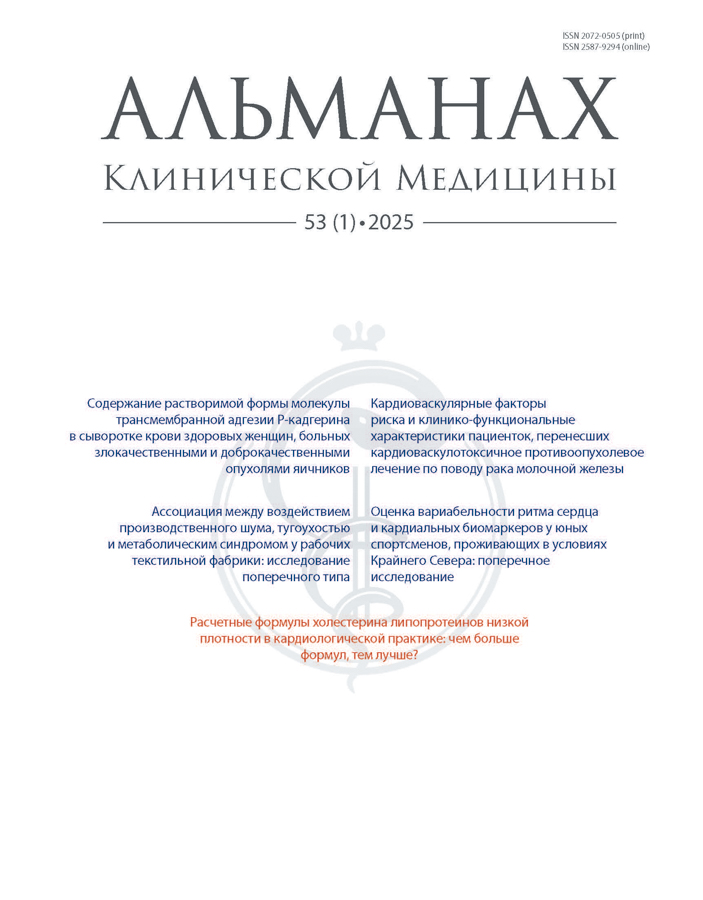Особенности биологических свойств бактерий вида Listeria innocua, выделенных на территории Приморского края
- Авторы: Зайцева Е.А.1
-
Учреждения:
- ФГБОУ ВО «Тихоокеанский государственный медицинский университет» Минздрава России
- Выпуск: Том 45, № 2 (2017)
- Страницы: 143-159
- Раздел: ОРИГИНАЛЬНЫЕ СТАТЬИ
- URL: https://almclinmed.ru/jour/article/view/527
- DOI: https://doi.org/10.18786/2072-0505-2017-45-2-143-159
- ID: 527
Цитировать
Полный текст
Аннотация
Актуальность. Большинство случаев заболевания листериозом связаны с патогенным видом Listeria monocytogenes. В литературе появились сообщения о выделении из пищевых продуктов L. innocua с факторами патогенности, а также о случаях заболевания у людей, вызванных этим видом. Цель – оценить биологические свойства, в том числе патогенный потенциал L. innocua, выделенных из пищевых продуктов и объектов окружающей среды. Материал и методы. Проведено микробиологическое исследование культур L. innocua, изолированных из пищевых продуктов (n = 35) и объектов окружающей среды (n = 15) на территории Приморского края, а также исследование их антибиотикочувствительности. Результаты. У исследуемых культур L. innocua отмечена стабильность фенотипических проявлений биологических свойств – морфология, типичный рост колоний на питательных средах с характерным кисломолочным запахом, голубое или голубовато-зеленое свечение в косо проходящем свете, наличие каталазной активности и отсутствие оксидазной. Подвижность при 22 °С показали только 38 ± 6,9% L. innocua. Культуры L. innocua не ферментировали маннит (100% культур), разлагали до кислоты без газа рамнозу (70 ± 6,5%) и ксилозу (42,8 ± 7%). Листерии, выделенные из овощей и объектов внешней среды, с большей частотой ферментировали рамнозу (92,8 ± 7,2% исследуемых культур) и реже – ксилозу (28,5 ± 12,5%) по сравнению с изолятами L. innocua, полученными из мясных и рыбных продуктов. Отмечена вариабельность биохимической активности L. innocua по отношению к маннозе (92 ± 3,8%), сахарозе (85,7 ± 7,8%) и мелицитозе (76,2 ± 9,5%). Выявлены культуры L. innocua (34 ± 6,7%) с гемолитической активностью (αили β-типа), чаще у изолятов, выделенных из рыбной продукции. Липаза определялась у всех листерий независимо от источника выделения. Культуры L. innocua, выделенные из пищевых продуктов и объектов окружающей среды, показали высокую чувствительность к антимикробным препаратам из групп пенициллинов (ампициллин, карбенициллин, комбинированный препарат амоксициллина и клавулановой кислоты), аминогликозидов (гентамицин, амикацин), карбапенемов (меропенем), фторхинолонов (офлоксацин). Заключение. Отмечена вариабельность некоторых биологических свойств L. innocua в зависимости от источника выделения. Выявление на территории Приморского края культур листерий с атипичными свойствами требует более глубокого изучения микроорганизмов данного вида.
Об авторах
Е. А. Зайцева
ФГБОУ ВО «Тихоокеанский государственный медицинский университет» Минздрава России
Автор, ответственный за переписку.
Email: elza200707@mail.ru
Зайцева Елена Александровна – д-р мед. наук, доцент, профессор кафедры микробиологии и вирусологии
690002, г. Владивосток, пр. Острякова, 2
РоссияСписок литературы
- Тартаковский ИС, Малеев ВВ, Ермолаева СА. Листерии: роль в инфекционной патологии человека и лабораторная диагностика. М.: Медицина для всех; 2002. 200 с.
- Snapir YM, Vaisbein E, Nassar F. Low virulence but potentially fatal outcome – Listeria ivanovii. Eur J Intern Med. 2006;17(4):286–7. doi: 10.1016/j.ejim.2005.12.006.
- Guillet C, Join-Lambert O, Le Monnier A, Leclercq A, Mechaï F, Mamzer-Bruneel MF, Bielecka MK, Scortti M, Disson O, Berche P, Vazquez-Boland J, Lortholary O, Lecuit M. Human listeriosis caused by Listeria ivanovii. Emerg Infect Dis. 2010;16(1):136–8. doi: 10.3201/eid1601.091155.
- Rapose A, Lick SD, Ismail N. Listeria grayi bacteremia in a heart transplant recipient. Transpl Infect Dis. 2008;10(6):434–6. doi: 10.1111/j.1399-3062.2008.00333.x.
- Salimnia H, Patel D, Lephart PR, Fairfax MR, Chandrasekar PH. Listeria grayi: vancomycin-resistant, gram-positive rod causing bacteremia in a stem cell transplant recipient. Transpl Infect Dis. 2010;12(6):526–8. doi: 10.1111/j.1399-3062.2010.00539.x.
- Rocourt J, Hof H, Schrettenbrunner A, Malinverni R, Bille J. Acute purulent Listeria seelingeri meningitis in an immunocompetent adult. Schweiz Med Wochenschr. 1986;116(8):248–51.
- Perrin M, Bemer M, Delamare C. Fatal case of Listeria innocua bacteremia. J Clin Microbiol. 2003;41(11):5308–9. doi: 10.1128/JCM.41.11.5308-5309.2003.
- Andre P, Genicot A. First isolation of Listeria welshimeri in a human. Zentralbl Bakteriol Mikrobiol Hyg A. 1987;263(4):605–6.
- Montazeri N, Himelbloom BH, Oliveira AC, Leigh MB, Crapo CA. Refined liquid smoke: a potential antiListerial additive to coldsmoked sockeye salmon (Oncorhynchus nerka). J Food Prot. 2013;76(5):812–9. doi: 10.4315/0362-028X.JFP-12-368.
- Volokhov DV, Duperrier S, Neverov AA, George J, Buchrieser C, Hitchins AD. The presence of the internalin gene in natural atypically hemolytic Listeria innocua strains suggests descent from L. monocytogenes. Appl Environ Microbiol. 2007;73(6):1928–39. doi: 10.1128/AEM.01796-06.
- Johnson J, Jinneman K, Stelma G, Smith BG, Lye D, Messer J, Ulaszek J, Evsen L, Gendel S, Bennett RW, Swaminathan B, Pruckler J, Steigerwalt A, Kathariou S, Yildirim S, Volokhov D, Rasooly A, Chizhikov V, Wiedmann M, Fortes E, Duvall RE, Hitchins AD. Natural atypical Listeria innocua strains with Listeria monocytogenes pathogenicity island 1 genes. Appl Environ Microbiol. 2004;70(7):4256–66. doi: 10.1128/AEM.70.7.4256-4266.2004.
- El-Shenawy M, El-Shenawy M, Mañes J, Soriano JM. Listeria spp. in Street-Vended Readyto-Eat Foods. Interdiscip Perspect Infect Dis. 2011;2011:968031. doi: 10.1155/2011/968031.
- Зайцева ЕА, Ермолаева СА, Пуховская НМ, Мусатов ЮС, Иванов ЛИ, Сомов ГП. Распространение Listeria monocytogenes и ее роль в инфекционной патологии на Дальнем Востоке России. Тихоокеанский медицинский журнал. 2010;(4):19–23.
- Clayton EM, Daly KM, Guinane CM, Hill C, Cotter PD, Ross PR. Atypical Listeria innocua strains possess an intact LIPI-3. BMC Microbiol. 2014;14:58. doi: 10.1186/1471-2180-14-58.
- Rocha PR, Dalmasso A, Grattarola C, Casalone C, Del Piero F, Bottero MT, Capucchio MT. Atypical cerebral listeriosis associated with Listeria innocua in a beef bull. Res Vet Sci. 2013;94(1): 111–4. doi: 10.1016/j.rvsc.2012.07.017. 16. Fentahun T, Fresebehat A. Listeriosis in small ruminants: a review. Advan Biol Res. 2012;6(6): 202–9. doi: 10.5829/idosi.abr.2012.6.6.66159.
- Стародумова СМ, Зайцева ЕА. Способ быстрой идентификации бактерий рода Listeria и патогенного вида Listeria monocytogenes с помощью мультиплексной ПЦР. Тихоокеанский медицинский журнал. 2014;(1):95–7.
- El-Shenawy MA. Listeria spp. in the coastal environment of the Aqaba Gulf, Suez Gulf and the Red Sea. Epidemiol Infect. 2006;134(4): 752–7. doi: 10.1017/S0950268805005601.
Дополнительные файлы








